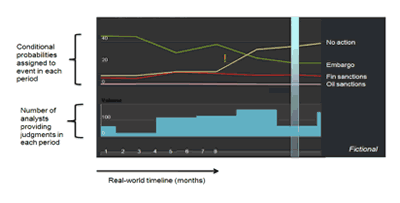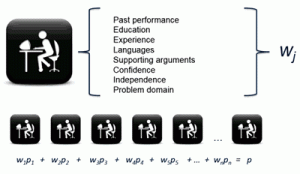
Notional ACE system output.

Notional ACE system output.
The goal of the Aggregative Contingent Estimation Program, sponsored by the Intelligence Advanced Research Projects Activity, is to enhance the accuracy, precision and timeliness of forecasts for a broad range of global events. The program develops advanced techniques to gather, weight and combine the judgments of people from many backgrounds and fields and in many different locations.
ACE is powered by human judgment, which makes it flexible enough to provide forecasts on just about any type of intelligence-forecasting question. Launched in 2010, ACE is based on the idea that combining forecasts made by an informed and diverse group of people often produces more accurate predictions of future events than those made by a single expert.
Download this case study (PDF, 54KB)
Website: ACE
ACE started with a “forecasting tournament”. Five teams of leading scholars from industry and academia competed to forecast events. They recruited thousands of research participants; each year, the participants answered about 100 questions related to social, economic and political events. Every day, the teams sent forecasts to an independent evaluator, who scored them based on actual outcomes. Each research team tried to produce the most accurate forecasts, competing against each other and against a benchmark group that used the unweighted average judgment of a group of forecasters.
After two years, one research team — the Good Judgment Project–substantially outperformed the others. In fact, Good Judgment’s improvement in accuracy was greater than the improvement of the other four research teams combined — about 70 percent over the benchmark. Forecast improvement was measured using Brier scoring, a method originally developed to evaluate weather forecasts.

Schematic drawing of the notional ACE weighting algorithm.
Four of the five teams had difficulty recruiting and retaining the number of people they needed, because continuous forecasting was somewhat time-consuming (taking about one hour per week). Teams also had to decide how best to use project resources — and whether to focus most of their effort on finding the best ways to efficiently collect probability judgments; on determining how best to combine and weight those judgments; or on developing training methods for forecasters.
In addition, the project’s initial concept faced resistance from potential participants and customers. Analysts are not often trained to think in quantitative terms and may be reluctant to provide numerical forecasts that can be scored for accuracy. However, letting forecasters be anonymous made it easier for them to take the risk and to take the time to develop the skills needed.
The team that won the ACE tournament (the Good Judgment Project) made substantial advances in all three areas:
ACE shows that meaningful geopolitical forecasts can be produced quickly and accurately on topics ranging from violent international confrontations to how long international leaders will stay in power. By better measuring exact levels of uncertainty, the project can also increase the rigor of intelligence analysis more generally. For the first time, we have a quantitative system flexible enough for rapid analysis of almost any subject. Where traditional analysis can take days or weeks, ACE forecasts can be obtained in a matter of hours. Consumers of ACE forecasts can be confident in their accuracy because the technologies have been validated in a real-world forecasting tournament.
The ACE case study illustrates the following steps in the Federal Citizen Science and Crowdsourcing Toolkit:
Dr. Steve Rieber
Email: steven.rieber@iarpa.gov